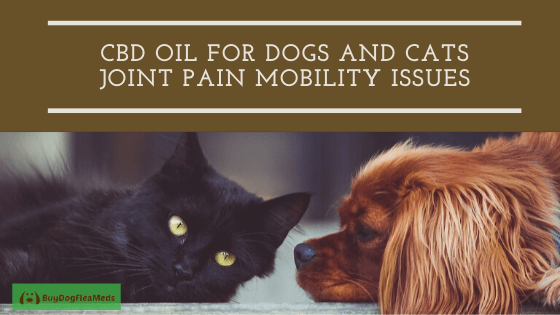Just like humans, pets such as dogs and cats can also develop joint pain that can result in impaired mobility. This can affect the quality of their lives.
Joint pain can be short-term (acute) or chronic. There is a number of factors that can cause cats and dogs to develop this condition.
What is Joint Pain? What Causes Joint pain in Dogs and Cats?
Joint pain is commonly associated with osteoarthritis, which typically develops in older pets, as well as in large breeds. But dogs of all sizes can develop arthritis as they age.
Joint pain can also develop as a result of developmental issues such as hip dysplasia. This condition happens when the hip joint does not develop properly. As a result, the joint deteriorates over time and eventually will cause a loss of function.
In cats, joint pain is generally caused by degeneration of cartilage with age. Other factors that can cause cartilage degeneration include weight gain, infection and injury.
Symptoms of Joint Pain and Mobility Issues
The most common sign of joint pain is decreased mobility. Since it is more difficult for dogs and cats to move around, they may become less active than in the past. For instance, you may notice that they avoid climbing stairs and running.
Another symptom is a change in gait. Dogs and cats with joint pain may start walking with a limp. If the pain becomes too serious, you may see your pet start holding up the affected limb since they don’t want to put weight on it.
Preventing Joint Pain in Dogs and Cats
One thing that you can do to prevent joint pain is to maintain your dog and cat at a healthy weight. If they are overweight, it will put more stress on their joints.
You can help maintain your pets at a healthy weight by feeding them a healthy and balanced diet. You should also take them on daily walks or otherwise get regular aerobic exercise.
One thing you should avoid is to over-exercise on weekends to make up for pets being sedentary the rest of the week. This can lead to injuries due to over-exertion.
You should also discourage leaping behavior in smaller dogs. In addition, never jerk your dog’s neck when they are on a leash since this can cause cervical trauma that can lead to joint pain over time.
Natural Home Remedy Treatments for Dog and Cat Joint Pain
Pets with joint pain are commonly prescribed non-steroidal anti-inflammatory drugs or NSAIDs. These drugs relieve pain so that affected dogs and cats can start to move normally again. However, NSAIDs can potentially damage the kidney, stomach or liver so they must only be given under the supervision of your vet.
You can also give your pet supplements that help protect and nourish joint cartilage. In particular, chondroitin and glucosamine are effective in alleviating joint pain. They work by helping joint cartilage stay lubricated and moist, and stimulating cartilage cells to repair themselves if damage has already occurred.
Another effective supplement is Omega-3 fatty acids, since they have been shown to reduce inflammation. They may also help prevent further damage if your pet sustains a joint injury.
In severe cases, your vet may recommend surgical treatments such as total joint replacement or arthroscopic cleaning of the joints. Physical therapy is also becoming popular, with treatments including electric stimulation of the joints and underwater treadmills.
Alternative Treatments for Dog and Cat Joint Pain
If you don’t want to give your pets NSAIDs or other traditional treatments, there is a number of alternative remedies you can try.
Turmeric is a spice that is used in curry and other foods. It contains curcumin, which is an antioxidant that can help reduce joint pain by reducing damage to the cell walls of joints.
Boswellia scara is a tree from whose resin the oil frankincense is derived. The resin also has an active ingredient that works similar to NSAIDs in helping alleviate inflammation.
These two plants are taken orally as tablets. However, you should consult with your vet as to the proper dosage to give your cat or dog.
There are also topical oils that you can apply to the affected joints. For instance, wintergreen oil can be rubbed on the area surrounding the joints. Cinnamon and cassia contain active ingredients that act similar to NSAIDs such as Ketoprofen and Novox.
Cannabinoid products derived from the cannabis plant are increasingly seen as beneficial in treating pain and inflammation. According to a 2018 study published in Frontiers in Veterinary Science, dogs with osteoarthritis that were treated with CBD oil had decreased pain. The owners reported no side effects during the treatment period.
How Much CBD Should I Give My Pet?
At present, there is no standard accepted dosage for CBD oil since studies are still being conducted on its use with cats and dogs. Hence, if you choose to give CBD to your pet, you should always work with your veterinarian to determine the proper dosage. He will set the dose based on factors such as body weight and physical condition.
In the study cited above from Frontiers in Veterinary Science, the dosage used by researchers was 2mg of CBD per kg of body weight, given twice a day. This dosage was seen as helping dogs affected with osteoarthritis enjoy significant reduction in pain and become more active. But you should only give this amount of CBD if your vet says it’s okay.
How Can I Find Quality CDB Oil?
If you choose to give your pet CBD oil, make sure that you buy from a trusted source. At present, the FDA has not yet given approval to market cannabis products to treat any condition or disease. This does not mean that cannabis-derived products are unsafe, but since they are not yet regulated, you have to be careful which product you buy.
The best way to ensure that you are getting CBD oil that has the appropriate cannabinoid content is to ask your vet for recommendations. Many vets may also stock CBD oil so it would be safe to buy directly from them.
Reference:
https://www.handicappedpets.com/blog/cbd-oil-for-improved-pet-mobility/
https://www.healthline.com/health/cbd-oil-for-pain#further-research
https://www.ncbi.nlm.nih.gov/pubmed/28885454
https://www.ncbi.nlm.nih.gov/pubmed/16282192
https://www.ncbi.nlm.nih.gov/pmc/articles/PMC6065210/

